Portal Usability Test Answer Key¶
Contact authors: Andrés A. Plazas Malagón and Gloria Fonseca Alvarez
Last verified to run: 2024-03-02
Link to Portal usability tests: RSP Feedback Exercises
Introduction: The following is the answer key for the tasks in the Portal usability test. The test was designed to understand how users interact with the Portal functionality. Anyone is welcome to do the Portal usability tests and submit their responses via the following Google form: https://forms.gle/PdqNgW8ErV277tih9
Exercise 1 (beginner)¶
Retrieve the g_psfFlux, g_calibFlux, and the g_extendedness columns from the DP0.2
Object catalog for objects within 15 arcminutes of the galaxy cluster at Right Ascension 55.75 degrees and Declination -32.27 degrees. Plot the psfFlux vs. the calibFlux flux columns.
In the results table, impose a constraint to only plot objects with extendedness equal to 1. Change the plot symbols to open purple circles.
Step 1. Query the DP0.2 Object catalog¶
1.1. Click on “DP0.2 Catalogs” tab on the top, ensure Table Collection (Schema) is “dp02_dc2_catalogs” (left drop-down menu) and the Table is “dp02_dc2_catalogs.Object” (right drop-down menu).
1.2. Under “Enter Constraints”, enter the coordinates “55.75, -32.27” for “Coordinates or Object Name”. Next to “Radius”, from the drop down menu choose “arcminutes” and then enter “15”.
1.3. Select the output columns “coord_ra”, “coord_dec”, “g_psfFlux” “g_calibFlux” and “g_extendedness” and “detect_isPrimary”. Click on the filter icon to show only the selected columns.
1.4. In the “constraints” column, enter “=1” for “detect_isPrimary”.
1.5. Set the “Row Limit” to 20000, to only retrieve 20000 objects.
1.6. Click “Search” at lower left.
Step 2. Create a g psfFlux vs. g calibFlux diagram¶
2.1. Click on the “Active Chart” tab in the right panel, then click on the settings icon (single gear) and set “X” to be “g_calibFlux”, and “Y” to be “g_psfFlux”. Click “Apply”, then “Close”.
Step 3. Plot only extended objects¶
3.0. In the results table, under the column “g_extendedness”, enter “= 1”. Click on the filter icon.
3.1 Click on the Active Chart settings icon (single gear on right-hand panel) and click on “Trace Options”. Next to “Symbol”, from the drop down menu choose “circle-open”. Next to “Color”, click on the magnifying glass and select a purple color, then click “ok”. Click “Apply” and then “Close”.

The g psfFlux vs g calibFlux diagram for extended objects¶
Exercise 2 (beginner)¶
Create a g-r color vs. i magnitude diagram using the calibFlux columns in the DP0.2 Object catalog,
for all objects within 120 arcseconds of Right Ascension 60 degrees and Declination -35 degrees.
Zoom in on the clump of points with color values approximately in the range of -4 < g-r < 4.
Save the plot as a PNG file to your local computer. Hint: After retrieving the {band}_calibFlux columns,
use the expression (-2.5*log10({band}_calibFlux) + 31.4) to convert the fluxes in nanoJankys to magnitudes in the AB system.
Step 1. Query the DP0.2 Object catalog¶
1.1. Click on “DP0.2 Catalogs” tab at the top, ensure Table Collection is set to “dp02_dc2_catalogs” (left drop-down menu) and the Table is set to “dp02_dc2_catalogs.Object” (right drop-down menu).
1.2. Under “Enter Constraints”, select the box to the left of “Spatial”. For “Coordinates or Object Name”, use the coordinates “60, -35”. Next to “Radius”, from the drop down menu choose “arcseconds” and then enter “120”.
1.3. In the table on the right, under “Output Column Selection and Constraints”, select “coord_ra”, “coord_dec”, “detect_isPrimary”, “g” “r” and “i_calibFlux”. Click on the filter icon to show only the selected columns.
1.4. In the “constraints” column, enter “=1” for “detect_isPrimary”.
1.5. Click “Search” at the lower left.
Step 2. Create a g-r color vs i magnitude diagram¶
2.1. Click on the “Active Chart” tab in the right panel, then click settings icon (single gear) to change the plot parameters. Set “X” to be “(-2.5 * log10(g_calibFlux)) - (-2.5 * log10(r_calibFlux))” and “Y” to be “-2.5 * log10(i_calibFlux) + 31.4”.
2.2. Click on “Chart Options” and set “X Label” to “color (g-r)”. Set “Y Label” to “magnitude (i)”, and underneath check the “Options” box for “reverse”. Click “Apply” then “Close”.
Step 3. Zoom-in and save the diagram¶
3.1. Click on the Zoom-in icon (magnifying glass with a plus) and click and drag over the clump on points.
3.2. Click on “Pin Chart” and then the save icon (next to the 1x magnifying glass) to download the chart as a PNG.
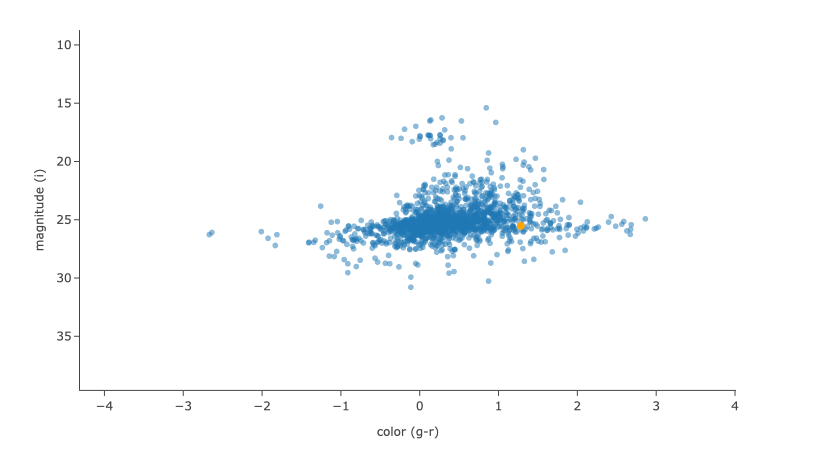
The g-r color vs i magnitude diagram¶
Exercise 3 (intermediate)¶
Retrieve the four DP0.2 processed visit images (PVI), also known as “calexp” images, obtained with LSST band i,
before the date of MJD 59840, whose boundaries contain the point with Right Ascension 55.75 degrees
and Declination -32.27 degrees. In the results view, choose the option to display the images in a grid.
Use the “Image center drop down” tool to center the first displayed image on the search coordinates.
Use the “Image alignment drop down” tool to align and lock all displayed images by the World Coordinate System (WCS)
and zoom-in 3 times.
Step 1. Retrieve processed visit images¶
1.1. Click the “DP0.2 Images” tab on the top.
1.2. Under “Observation Type and Source”, choose “Calibration Level” 2, for PVIs.
1.3. Under “Location”, from the drop-down menu next to “Query Type”, choose “Observation boundary contains point”. For “Coordinates or Object Name”, use the coordinates “55.75, -32.27”.
1.4. Under “Timing”, from the drop-down menu next to “Time of Observation”, choose “Overlapping specified range” and select “MJD values”. Enter “59840” for “End Time”.
1.5. Under “Spectral Coverage”, select “By Filter Bands” and select “i”.
1.6. Click “Search” at lower left.
Step 2. View and align the images¶
2.1 Click on the “hamburger” icon (three lines in a box) in the upper left hand corner, scroll down to “Results Layout” and select “Tables|Coverage Images Charts” option. To display the PVIs, click on “Data Product:ivoa.ObsCore-dat…” tab in the right side panel.
2.2. Above the image, click on the grid icon (hover-over text “Tile all images in the search result table”) to simultaneously view all 4 i band PVIs.
2.3. Click on the first image and choose the “center” icon (square with circle in the center, hover-over text “Image center drop down.”) in the right panel upper icons, and in the “<Enter position to center on>” box enter coordinates, “55.75, -32.27”, and then click “Go & Mark”.
2.4. Click on the align icon above the image (hover-over text “Image alignment drop down.”, second icon from the right) and under “Align and Lock Options” select “by WCS”.
2.5. Click the Zoom icon and then Zoom-in (magnifying glass with a plus) 3-6 times.
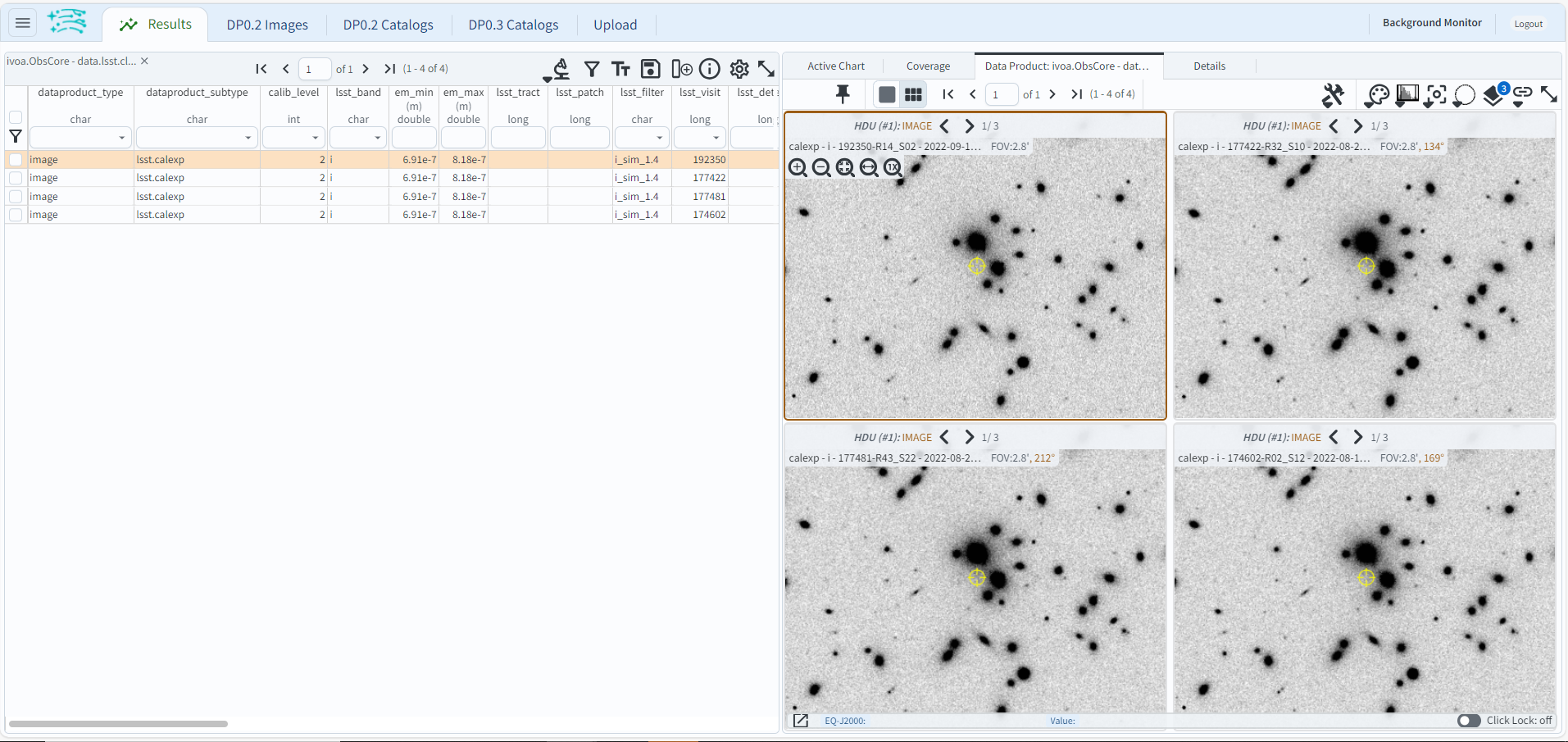
A zoom-in of the aligned i-band PVIs¶
Exercise 4 (intermediate)¶
Use the ADQL interface to obtain, from the DP0.2 DiaSource table, an r-band light curve for the Type Ia supernova
which has a diaObjectId of 1250953961339360185. Retrieve the r-band fluxes and their errors derived from
a linear least-squares fit of a PSF model, and the effective mid-exposure time, for all diaSources associated
with this diaObjectId. Plot the light curve as the flux as a function of time, with error bars associated with
each flux point. Change the plot style to use connected points, the point style to be red circles, and then sort the
results by midPointTai.
Update the plot axes labels to be “PSF Difference-Image Flux” and “MJD of the Exposure Midpoint”.
Save the plot as a PNG file to your local computer.
Hint: In the ADQL query, the filter name will need to be
formatted as a string (e.g., 'r').
Step 1. Query the DiaSource table with ADQL¶
1.1. On the upper right of the portal aspect, click on “Edit ADQL”.
1.2. Enter the following ADQL code into the “ADQL Query” box:
SELECT diasrc.diaObjectId, diasrc.diaSourceId,
diasrc.filterName, diasrc.midPointTai, diasrc.psFlux, diasrc.psFluxErr
FROM dp02_dc2_catalogs.DiaSource AS diasrc
WHERE diasrc.diaObjectId = 1250953961339360185
AND diasrc.filterName = 'r'
1.3. Click “Search” at lower left.
Step 2. Create a light curve plot¶
2.1. Click on the Active Chart settings icon and set “X” to be “midPointTai”, and “Y” to be “psFlux”. Under “Y”, select “Error” and enter “psFluxErr”.
2.2. From the drop-down menu next to “Trace Style”, choose “Connected points” and under “Trace options” enter “red” for “Color”.
2.3. Click on “Chart Options” and set “X Label” to “MJD of the Exposure Midpoint” and “Y Label” to “PSF Difference-Image Flux”. Click “Apply” and then “Close”.
2.4. Click on the table column “midPointTai” to sort the results.
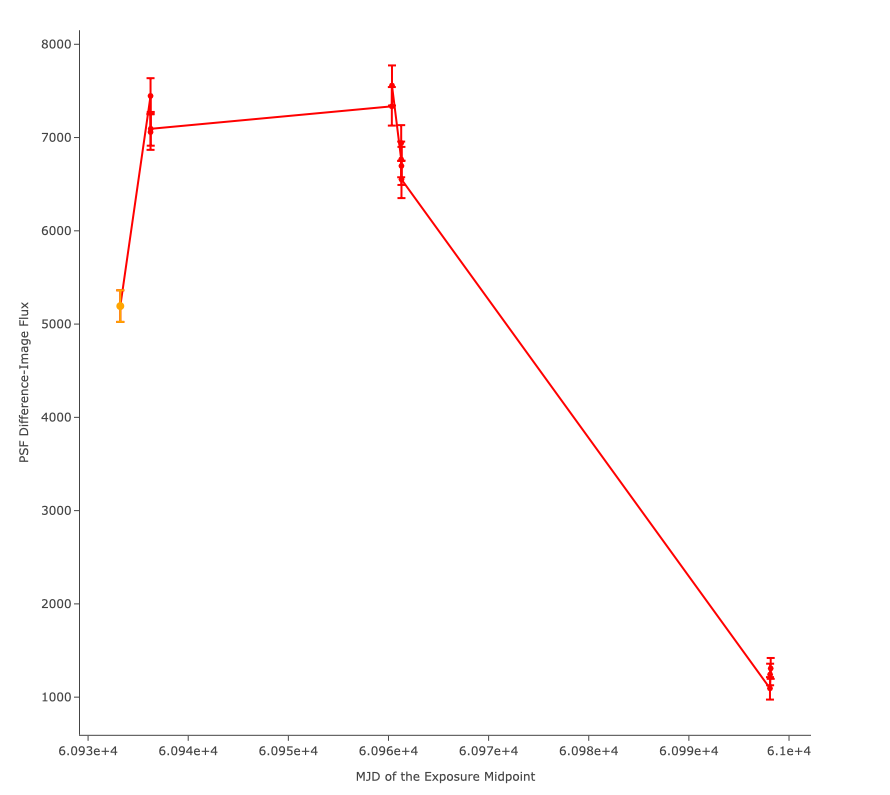
The light curve after sorting by the exposure midpoint¶
2.5. Click on the Active Chart “save this chart” icon (disc icon) to download the image as a PNG.
Exercise 5 (experienced)¶
The following figure, which corresponds to Figure 15 from the
The LSST DESC DC2 Simulated Sky Survey paper,
has three panels: the grid of tracts in the DC2 simulation area on the left, the image of tract 3828 on the center,
and a zoom-in image approximately centered near a particularly bright elongated galaxy on the right.
The galaxy is located at Right Ascension = 3h46m56.21s and Declination = -36d05m27.7s (EQ_J2000).
Use the Portal Aspect of the RSP to reproduce the following figure, which shows an image of the same galaxy
in the r band, including:
The compass with cardinal points (N-E compass)
The footprint of the Hubble Space Telescope Wide Field Camera 3 - Infrared channel (WFC3/IR)
The extraction of a light profile of the galaxy. Save the light profile as a CSV file.
Hint: Use a color stretch “Linear: Stretch -1 Sigma to 30 Sigma” to resemble the figure below.
Step 1. Find the image of the galaxy in the r band¶
1.1. Click “DP0.2 Images”.
1.2 In “Calibration Level” under “Observation Type and Source”, check the box “3”.
1.3. In the table on the right, under “Output Column Selection and Constraints”, search for “lsst_tract” and enter “=3828” in the “constraints” column.
1.4. Enter the galaxy’s right ascension and declination, 3h46m56.21s, -36d05m27.7s, in “Coordinates or Object Name” under “Location”.
1.5. Click “Search” at the lower left.
1.6. In the table at the bottom select the third row, corresponding to the image in the “r” band.
1.7. In the “Data Product: ivoa.obsCore” tab where the image is displayed, enter the galaxy coordinates again in the “Image Center Dropdown”, and click on “Go”. use the zoom icons at the upper left part to zoom in the galaxy center.
1.8. In the same “Data Product: ivoa.obsCore” tab, click on the stretch drop down, and select “Linear: Stretch -1 Sigma to 30 Sigma”
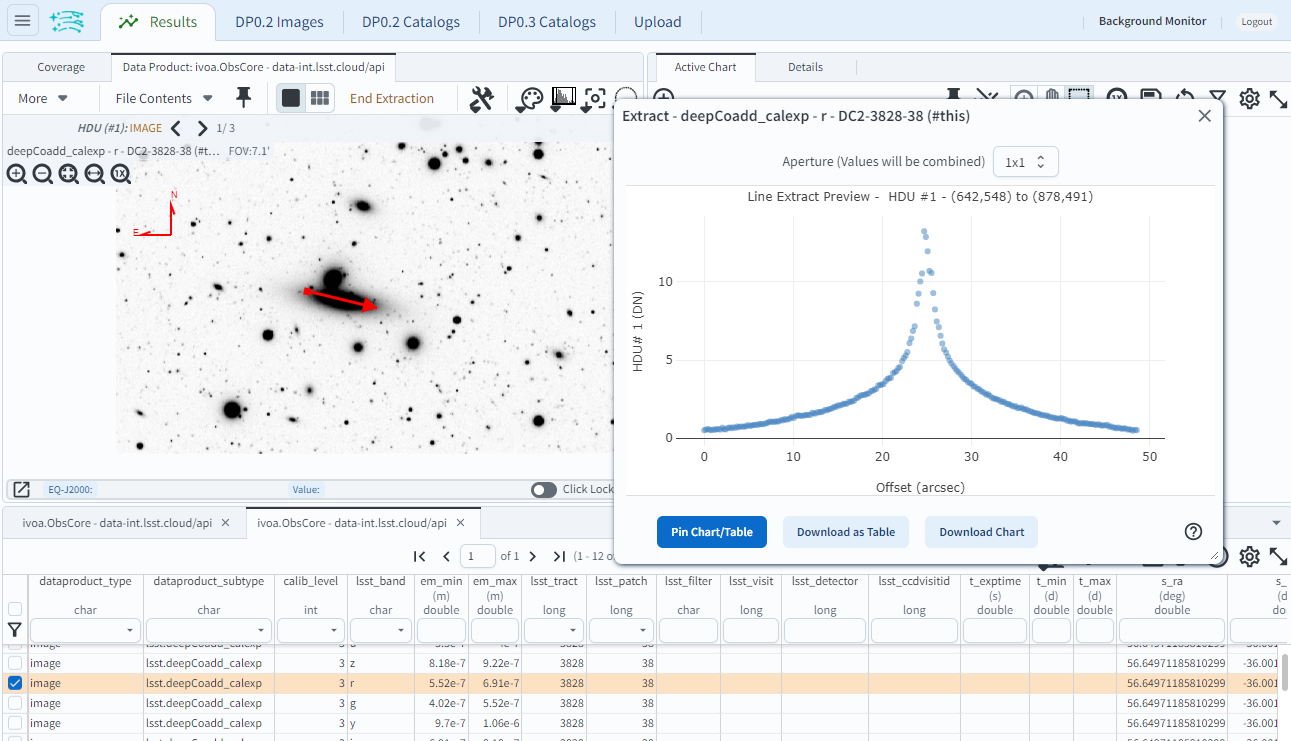
A screenshot of the image display and plot.¶
Step 2. Overlay compass and WFC3-IR’s field of view¶
2.1. Select the “Tools” drop-down (the icon with a wrench and hammer) menu. Go to “Layers” and click on the first icon the left with an “N” and an “E” to overlay the compass with the cardinal points.
2.2. In the same “Layers” row, select the last icon “Overlay Markers and Instrument Footprints”. Go to “Add HST footprint” and select “WFC3/IR”. Click on the footprint that appears on the image and move it so that it is centered on the galaxy.
Step 3. Extract the flux profile of the galaxy and save it as a CSV file¶
3.1. In the “Tools” drop-down menu, go to “Extract”. Click on “Extract Line from Image” and draw a line along the galaxy by dragging the cursor in the image. The light profile should populate automatically in a new window.
3.2 In the light profile window, click on “Download as Table” and select the CSV format before saving.
Exercise 6 (experienced)¶
Query the DP0.2 Object catalog for the galaxy cluster around Right Ascension 3h43m00.00s and Declination -32d16m19.00s
to visualize the region where the cluster is and plot the “red sequence” in a color-magnitude diagram
(for example, r-i vs i), as illustrated in the image below.
Then, select the points in the red sequence to highlight the cluster members in the image, as shown in the image below.
Hint 1: use a search radius of 200 arcseconds.
Hint 2: you can use the scisql_nanojanskyToAbMag SQL function to convert
fluxes to magnitudes (filter out negative fluxes before using the function).
Definition: The red sequence in galaxy clusters refers to a tight correlation observed in color-magnitude diagrams, where many of the galaxies in a cluster show a similar red color and brightness, indicating they are older, more evolved galaxies with less star formation.
Step 1. Visualize the region of the cluster¶
1.1. Under “Enter Constraints”, enter the coordinates “3h43m00.00s, -32d16m19.00s” for “Coordinates or Object Name”. Next to “Radius”, from the drop down menu choose “arcseconds” and then enter “200”.
1.2. Select the output columns “coord_ra”, “coord_dec”, “r” and “i_cModelFlux”, “r” and “i_extendedness” and “detect_isPrimary”. In the “constraints” column, enter “=1” for “r” and “i_extendedness” and for “detect_isPrimary”.
1.3. Click “Search” at lower left.
1.4. Under the “Coverage” tab, click on the layers icon (hover-over text “manipulate overlay display”) and unselect “Coverage”.
Step 2. Create a color-magnitude diagram¶
2.1. Click on the Active Chart settings icon (two gears) and set “X” to be “to be “-2.5 * log10(i_cModelFlux) + 31.4” and “Y” to be “(-2.5 * log10(r_cModelFlux)) - (-2.5 * log10(i_cModelFlux))”.
2.2. Under Chart Options, set “Chart title” to “Red Sequence”. Set “X Label” to “i” and set “Y Label” to “r-i”. Click “Apply”.
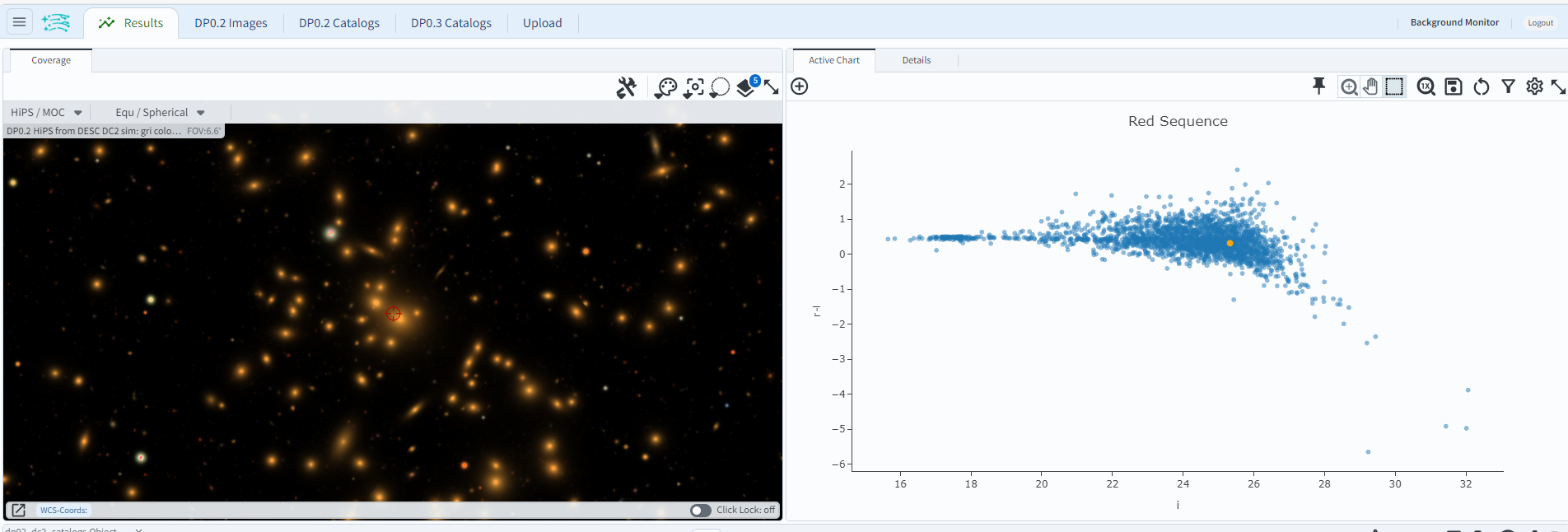
Red sequence in a color-magnitude diagram¶
Step 3. Highlight the cluster members¶
3.1. On the chart on the right, click and drag over the points roughly with 16 < i < 20.
3.2. Click on the filter icon (next to “Pin chart”) to show only the selected points.
3.3. Under the “Coverage” tab, click on the layers icon (hover-over text “manipulate overlay display”) and select “Coverage”.
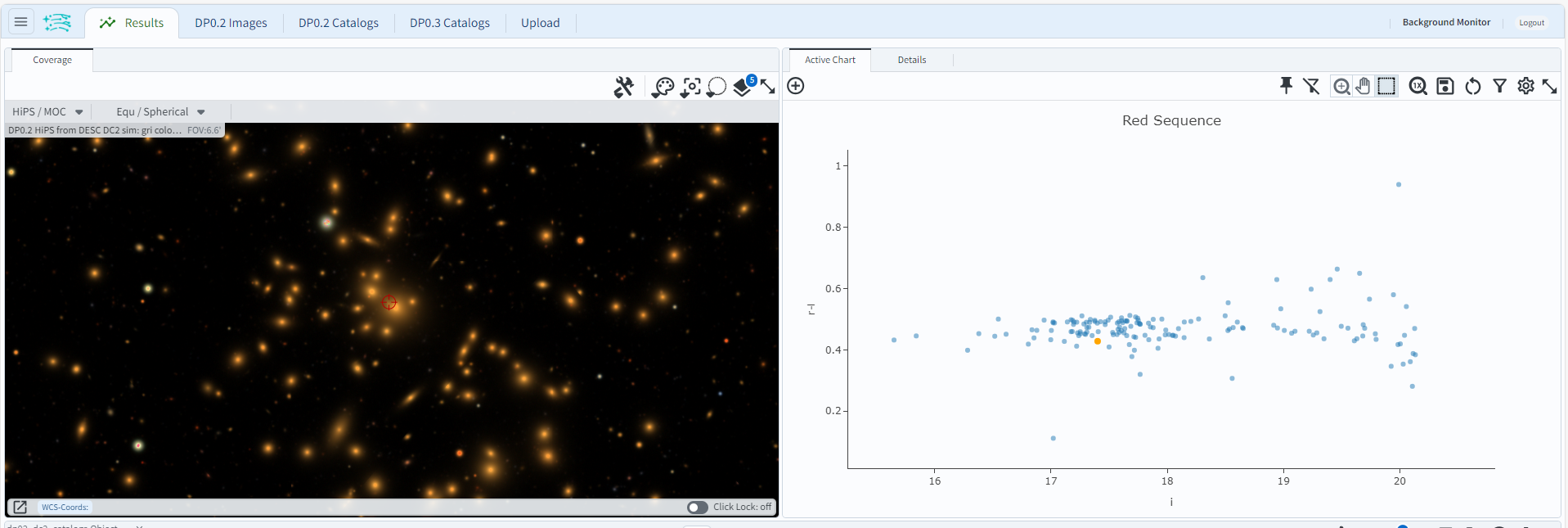
Red sequence with cluster members highlighted¶